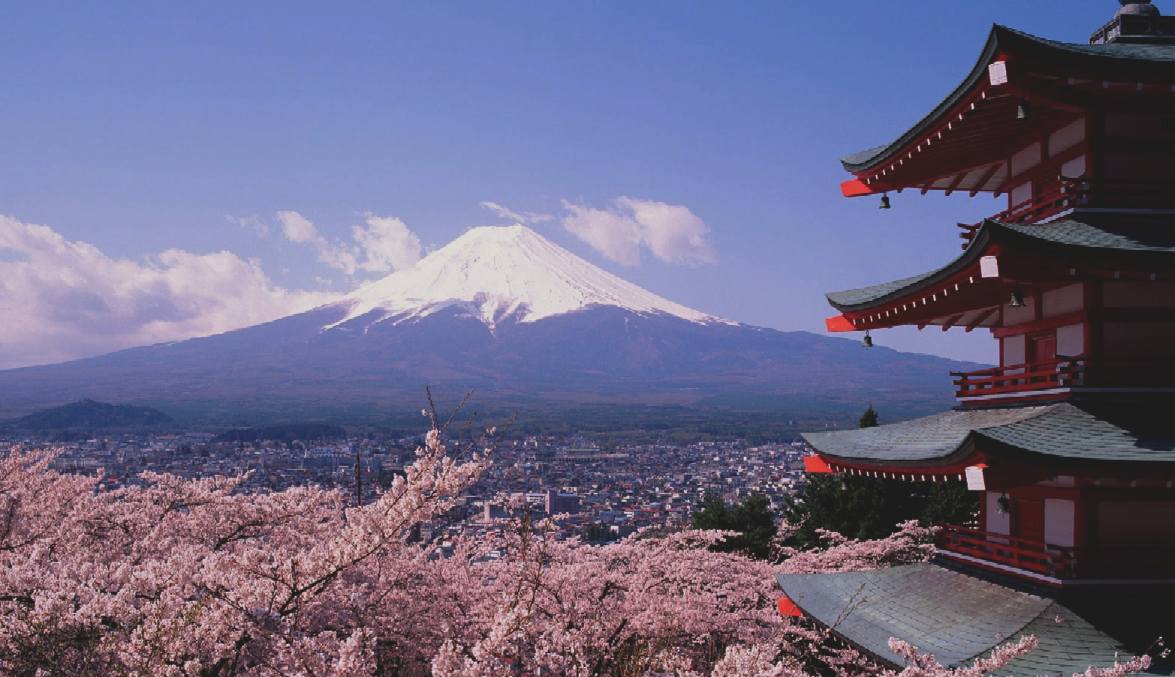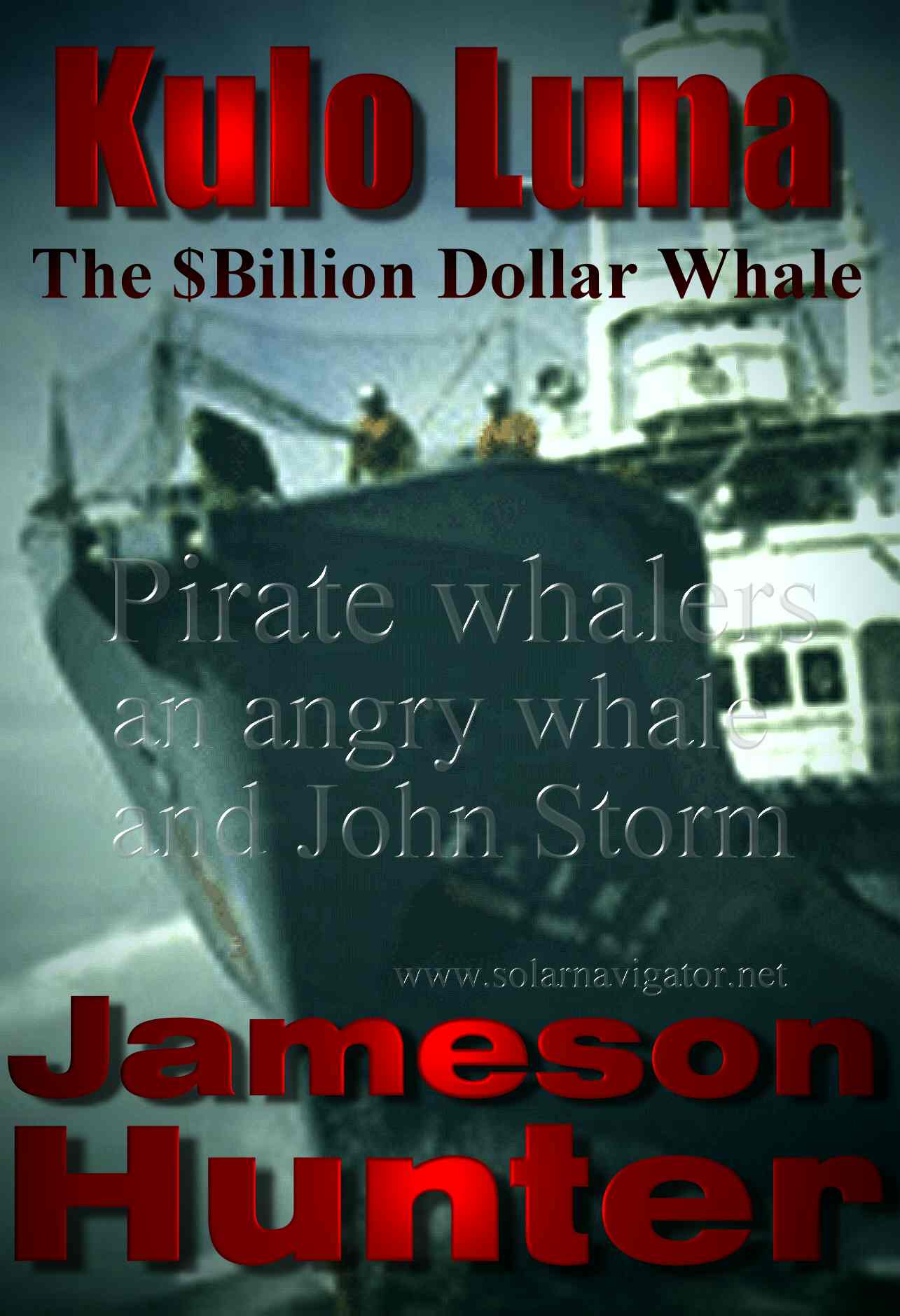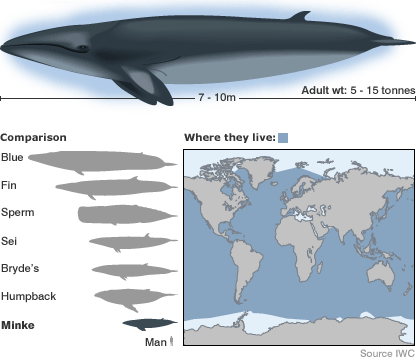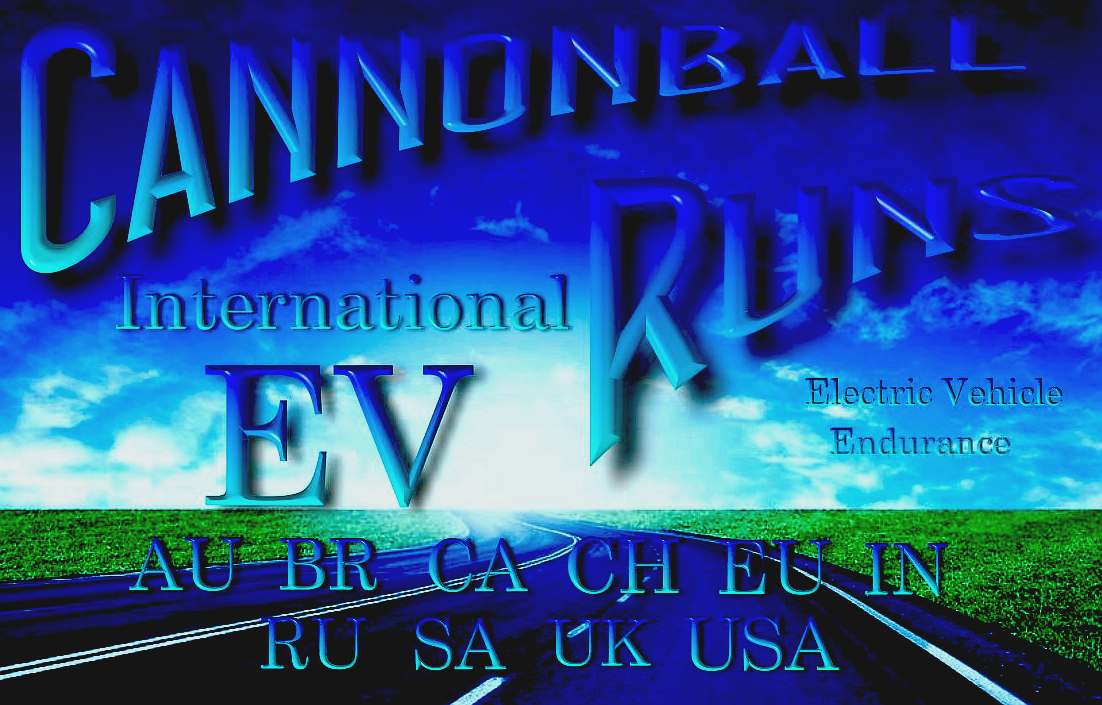|

Japan
is an island nation in East Asia. Located in the Pacific Ocean, it lies to the east of the Sea of Japan, China, North Korea, South Korea and Russia, stretching from the Sea of Okhotsk in the north to the East China Sea and Taiwan in the south. The characters that make up Japan's name mean "sun-origin", which is why Japan is sometimes referred to as the "Land of the Rising
Sun".
Japan is an archipelago of 6,852 islands. The four largest islands are Honshu, Hokkaido, Kyushu, and Shikoku, which together comprise about ninety-seven percent of Japan's land area. Japan has the world's tenth-largest population, with over 127 million people. Honshū's Greater Tokyo Area, which includes the de facto capital city of Tokyo and several surrounding prefectures, is the largest metropolitan area in the world, with over 30 million residents.
Archaeological research indicates that people lived in Japan as early as the Upper Paleolithic period. The first written mention of Japan is in Chinese history texts from the 1st century AD. Influence from other nations followed by long periods of isolation has characterized Japan's history. From the 12th century until 1868, Japan was ruled by successive feudal military dictatorships (shogunates) in the name of the Emperor. Japan entered into a long period of isolation in the early 17th century, which was only ended in 1853 when a United States fleet pressured Japan to open to the West. Nearly two decades of internal conflict and insurrection followed before the Meiji Emperor was restored as head of state in 1868 and the Empire of Japan was proclaimed, with the Emperor as a divine symbol of the nation. In the late 19th and early 20th centuries, victory in the First Sino-Japanese War, the Russo-Japanese War and World War I allowed Japan to expand its empire during a period of increasing militarism. The Second Sino-Japanese War of 1937 expanded into part of World War II in 1941, which came to an end in 1945 following the atomic bombings of Hiroshima and Nagasaki. Since adopting its revised constitution in 1947, Japan has maintained a unitary constitutional monarchy with an emperor and an elected legislature called the Diet.
A major economic power, Japan has the world's third-largest economy by nominal GDP and by purchasing power parity. It is also the world's fourth-largest exporter and fourth-largest importer. Although Japan has officially renounced its right to declare war, it maintains a modern military with the sixth largest military budget, used for self-defense and peacekeeping roles. After Singapore, Japan has the lowest homicide rate (including attempted homicide) in the world. According to Japan's health ministry, Japanese women have the second highest life expectancy of any country in the world. According to the
United Nations, Japan also has the third lowest infant mortality rate.

GOVERNMENT
Japan is a constitutional monarchy where the power of the Emperor is very limited. As a ceremonial figurehead, he is defined by the constitution as "the symbol of the state and of the unity of the people". Power is held chiefly by the Prime Minister of Japan and other elected members of the Diet, while sovereignty is vested in the Japanese people. Akihito is the current Emperor of Japan; Naruhito, Crown Prince of Japan, stands as next in line to the throne.
Japan's legislative organ is the National Diet, a bicameral parliament. The Diet consists of a House of Representatives with 480 seats, elected by popular vote every four years or when dissolved, and a House of Councillors of 242 seats, whose popularly elected members serve six-year terms. There is universal suffrage for adults over 20 years of age, with a secret ballot for all elected offices. In 2009, the social liberal Democratic Party of Japan (DPJ) took power after 54 years of the liberal conservative Liberal Democratic Party's (LDP) rule. In the 2012 general election, the LDP regained control of government. It holds 294 seats in the lower house and 83 seats in the upper house.
The Prime Minister of Japan is the head of government and is appointed by the Emperor after being designated by the Diet from among its members. The Prime Minister is the head of the Cabinet, and he appoints and dismisses the Ministers of State. Naoto Kan was designated by the Diet to replace Yukio Hatoyama as the Prime Minister of Japan on 2 June 2010. Although the Prime Minister is formally appointed by the Emperor, the Constitution of Japan explicitly requires the Emperor to appoint whoever is designated by the Diet. Emperor Akihito formally appointed Kan as the country's 94th Prime Minister on 8 June.
Historically influenced by Chinese law, the Japanese legal system developed independently during the Edo period through texts such as Kujikata Osadamegaki. However, since the late 19th century the judicial system has been largely based on the civil law of Europe, notably Germany. For example, in 1896, the Japanese government established a civil code based on a draft of the German Bürgerliches Gesetzbuch; with post–World War II modifications, the code remains in effect. Statutory law originates in Japan's legislature and has the rubber stamp of the Emperor. The Constitution requires that the Emperor promulgate legislation passed by the Diet, without specifically giving him the power to oppose legislation. Japan's court system is divided into four basic tiers: the Supreme Court and three levels of lower courts. The main body of Japanese statutory law is called the Six Codes.

FOREIGN RELATIONS & MILITARY
Japan is a member of the G8, APEC, and "ASEAN Plus Three", and is a participant in the East Asia Summit. Japan signed a security pact with Australia in March 2007 and with India in October 2008. It is the world's third largest donor of official development assistance after the United States and France, donating US$9.48 billion in 2009.
Japan has close economic and military relations with the United States; the US-Japan security alliance acts as the cornerstone of the nation's foreign policy. A member state of the United Nations since 1956, Japan has served as a non-permanent Security Council member for a total of 20 years, most recently for 2009 and 2010. It is one of the G4 nations seeking permanent membership in the Security Council.
Japan is engaged in several territorial disputes with its neighbors: with Russia over the South Kuril Islands, with South Korea over the Liancourt Rocks, with China and Taiwan over the Senkaku Islands, and with China over the EEZ around Okinotorishima. Japan also faces an ongoing dispute with North Korea over the latter's abduction of Japanese citizens and its nuclear weapons and missile program (see also Six-party talks).
Japan maintains one of the largest military budgets of any country in the world. Japan contributed non-combatant troops to the Iraq War but subsequently withdrew its forces. The Japan Maritime Self-Defense Force is a regular participant in RIMPAC maritime exercises.
Japan's military is restricted by Article 9 of the Japanese Constitution, which renounces Japan's right to declare war or use military force in international disputes. Japan's military is governed by the Ministry of Defense, and primarily consists of the Japan Ground Self-Defense Force (JGSDF), the Japan Maritime Self-Defense Force (JMSDF) and the Japan Air Self-Defense Force (JASDF). The forces have been recently used in peacekeeping operations; the deployment of troops to Iraq marked the first overseas use of Japan's military since World War II. Nippon Keidanren has called on the government to lift the ban on arms exports so that Japan can join multinational projects such as the Joint Strike Fighter.

DOOMSDAY
OPERATION GRAND SLAM -
Disillusioned extremists in Iran,
North Korea and Russia,
have grown impatient waiting for their leaders to act decisively, having
watched the Ukraine debacle
of Vladimir Putin rebound to weaken
their CRINK
axis members. This despite Hamas launching against Israel and
Houthi attacks on the Red
Sea. All that had the effect of waking the sleeping giant: NATO.
They
hatch a plot to kidnap top politicians from the west to create confusion,
as a prelude to an all out cyber
nuclear first and second strike, having first stockpiled sufficient gold
and weapons reserves, and fallout bunkers for their cells, to be able to
stage a second wave of conventional attacks, to in effect, take over the
world after the nuclear holocaust they
have engineered. Including assassinating their jaded leaders: Xi
Jinping; Vladimir
Putin, Iranian Grand Ayatollah, Ali
Khamenei, and Kim
Jong Un, supreme leader of communist North
Korea.
GEOGRAPHY
Japan has a total of 6,852 islands extending along the Pacific coast of East Asia. The country, including all of the islands it controls, lies between latitudes 24° and 46°N, and longitudes 122° and 146°E. The main islands, from north to south, are Hokkaidō, Honshū, Shikoku and Kyūshū. The Ryūkyū Islands, including Okinawa, are a chain to the south of Kyūshū. Together they are often known as the Japanese Archipelago.
About 73 percent of Japan is forested, mountainous, and unsuitable for agricultural, industrial, or residential use. As a result, the habitable zones, mainly located in coastal areas, have extremely high population densities. Japan is one of the most densely populated countries in the world.
The islands of Japan are located in a volcanic zone on the Pacific Ring of Fire. They are primarily the result of large oceanic movements occurring over hundreds of millions of years from the mid-Silurian to the Pleistocene as a result of the subduction of the Philippine Sea Plate beneath the continental Amurian Plate and Okinawa Plate to the south, and subduction of the Pacific Plate under the Okhotsk Plate to the north. Japan was originally attached to the eastern coast of the Eurasian continent. The subducting plates pulled Japan eastward, opening the Sea of Japan around 15 million years ago.
Japan has 108 active volcanoes. Destructive earthquakes, often resulting in tsunami, occur several times each century.[80] The 1923 Tokyo
earthquake killed over 140,000 people. More recent major quakes are the 1995 Great Hanshin earthquake and the 2011 Tōhoku earthquake, a 9.0-magnitude quake which hit Japan on 11 March 2011, and triggered a large
tsunami. On 24 May 2012, 6.1 magnitude earthquake struck off the coast of northeastern Japan. However, no tsunami was generated.

CLIMATE
The climate of Japan is predominantly temperate, but varies greatly from north to south. Japan's geographical features divide it into six principal climatic zones: Hokkaidō, Sea of Japan, Central Highland, Seto Inland Sea, Pacific Ocean, and Ryūkyū Islands. The northernmost zone, Hokkaido, has a humid continental climate with long, cold winters and very warm to cool summers. Precipitation is not heavy, but the islands usually develop deep snowbanks in the winter.
In the Sea of Japan zone on Honshū's west coast, northwest winter winds bring heavy snowfall. In the summer, the region is cooler than the Pacific area, though it sometimes experiences extremely hot temperatures because of the foehn wind. The Central Highland has a typical inland humid continental climate, with large temperature differences between summer and winter, and between day and night; precipitation is light, though winters are usually snowy. The mountains of the Chūgoku and Shikoku regions shelter the Seto Inland Sea from seasonal winds, bringing mild weather year-round.
The Pacific coast features a humid subtropical climate that experiences milder winters with occasional snowfall and hot, humid summers because of the southeast seasonal wind. The Ryukyu Islands have a subtropical climate, with warm winters and hot summers. Precipitation is very heavy, especially during the rainy season. The generally humid, temperate climate exhibits marked seasonal variation such as the blooming of the spring cherry blossoms, the calls of the summer cicada and fall foliage colors that are celebrated in art and literature.
The average winter temperature in Japan is 5.1 °C (41.2 °F) and the average summer temperature is 25.2 °C (77.4 °F). The highest temperature ever measured in Japan—40.9 °C (105.6 °F)—was recorded on 16 August 2007. The main rainy season begins in early May in Okinawa, and the rain front gradually moves north until reaching Hokkaidō in late July. In most of Honshū, the rainy season begins before the middle of June and lasts about six weeks. In late summer and early autumn, typhoons often bring heavy rain.
ECONOMY
Some of the structural features for Japan's economic growth developed in the Edo period, such as the network of transport routes, by road and water, and the futures contracts, banking and insurance of the Osaka rice brokers. During the Meiji period from 1868, Japan expanded economically with the embrace of the market economy.
Many of today's enterprises were founded at the time, and Japan emerged as the most developed nation in Asia. The period of overall real economic growth from the 1960s to the 1980s has been called the Japanese post-war economic miracle: it averaged 7.5 percent in the 1960s and 1970s, and 3.2 percent in the 1980s and early 1990s.
Growth slowed markedly in the 1990s during what the Japanese call the Lost Decade, largely because of the after-effects of the Japanese asset price bubble and domestic policies intended to wring speculative excesses from the stock and real estate markets. Government efforts to revive economic growth met with little success and were further hampered by the global slowdown in 2000. The economy showed strong signs of recovery after 2005; GDP growth for that year was 2.8 percent, surpassing the growth rates of the US and European Union during the same period.
As of 2011, Japan is the third largest national economy in the world, after the United States and China, in terms of nominal GDP, and the third largest national economy in the world, after the United States and China, in terms of purchasing power parity. As of January 2011, Japan's public debt was more than 200 percent of its annual gross domestic product, the largest of any nation in the world. In August 2011, Moody's rating has cut Japan's long-term sovereign debt rating one notch from Aa3 to Aa2 inline with the size of the country's deficit and borrowing level. The large budget deficits and government debt since the 2009 global recession and followed by earthquake and tsunami in March 2011 made the rating downgrade. The service sector accounts for three quarters of the gross domestic product.
Japan has a large industrial capacity, and is home to some of the largest and most technologically advanced producers of motor vehicles, electronics, machine tools, steel and nonferrous metals, ships, chemical substances, textiles, and processed foods. Agricultural businesses in Japan cultivate 13 percent of Japan's land, and Japan accounts for nearly 15 percent of the global fish catch, second only to China.[ As of 2010, Japan's labor force consisted of some 65.9 million workers. Japan has a low unemployment rate of around four percent. Almost one in six Japanese, or 20 million people, lived in poverty in 2007.[108] Housing in Japan is characterized by limited land supply in urban areas.
Japan's exports amounted to US$4,210 per capita in 2005. Japan's main export markets are China (18.88 percent), the United States (16.42 percent), South Korea (8.13 percent), Taiwan (6.27 percent) and Hong Kong (5.49 percent) as of 2009. Its main exports are transportation equipment, motor vehicles, electronics, electrical machinery and chemicals. Japan's main import markets as of 2009 are China (22.2 percent), the US (10.96 percent), Australia (6.29 percent), Saudi Arabia (5.29 percent), United Arab Emirates (4.12 percent), South Korea (3.98 percent) and Indonesia (3.95 percent).
Japan's main imports are machinery and equipment, fossil fuels, foodstuffs (in particular beef), chemicals, textiles and raw materials for its industries By market share measures, domestic markets are the least open of any OECD country. Junichiro Koizumi's administration began some pro-competition reforms, and foreign investment in Japan has soared.
Japan ranks 12th of 178 countries in the 2008 Ease of Doing Business Index and has one of the smallest tax revenues of the developed world. The Japanese variant of capitalism has many distinct features: keiretsu enterprises are influential, and lifetime employment and seniority-based career advancement are relatively common in the Japanese work environment. Japanese companies are known for management methods like "The Toyota Way", and shareholder activism is rare.
Some of the largest enterprises in Japan include Toyota, Nintendo, NTT DoCoMo, Canon, Honda, Takeda Pharmaceutical, Sony, Panasonic, Toshiba, Sharp, Nippon Steel, Nippon Oil, and Seven & I Holdings Co. It has some of the world's largest banks, and the Tokyo Stock Exchange (known for its Nikkei 225 and Topix indices) stands as the second largest in the world by market capitalization. Japan is home to 326 companies from the Forbes Global 2000 or 16.3 percent (as of 2006).

SCIENCE & TECHNOLOGY
Japan is a leading nation in scientific research, particularly technology, machinery and biomedical research. Nearly 700,000 researchers share a US$130 billion research and development budget, the third largest in the world. Japan is a world leader in fundamental scientific research, having produced sixteen Nobel laureates in either physics, chemistry or medicine, three Fields medalists, and one Gauss Prize laureate. Some of Japan's more prominent technological contributions are in the fields of electronics, automobiles, machinery, earthquake engineering, industrial robotics, optics, chemicals, semiconductors and metals. Japan leads the world in robotics production and use, possessing more than half (402,200 of 742,500) of the world's industrial robots.
The Japan Aerospace Exploration Agency (JAXA) is Japan's space agency; it conducts space, planetary, and aviation research, and leads development of rockets and satellites. It is a participant in the International Space Station: the Japanese Experiment Module (Kibo) was added to the station during Space Shuttle assembly flights in 2008. Japan's plans in space exploration include: launching a space probe to Venus, Akatsuki; developing the Mercury Magnetospheric Orbiter to be launched in 2013; and building a moon base by 2030.
On 14 September 2007, it launched lunar explorer "SELENE" (Selenological and Engineering Explorer) on an H-IIA (Model H2A2022) carrier rocket from Tanegashima Space Center. SELENE is also known as Kaguya, after the lunar princess of The Tale of the Bamboo Cutter. Kaguya is the largest lunar mission since the Apollo program. Its purpose is to gather data on the moon's origin and evolution. It entered a lunar orbit on 4 October, flying at an altitude of about 100 km (62 mi). The probe's mission was ended when it was deliberately crashed by JAXA into the
Moon on 11 June 2009.

The
Cannonball International EV series of road runs is open to all comers
provided they hold a valid driving license and stay within the speed
limits. This is an event for people who care about conserving our planet.
Cars must be based on production running gear, though modification of
drive and battery
or fuel cell
storage is allowed.
Make politicians around the world take notice of by attempting to equal
the speeds and endurance of petrol
and diesel powered
vehicles.
AOMORI
to KAGOSHIMA - TRANS-JAPAN CANNONBALL EV RUN SUGGESTED STOPS @50 MPH
|
START
|
AOMORI
|
NORTH
JAPAN
|
MILES
|
KM
|
HOURS
|
|
1st
STOP
|
Odate
|
Akita
|
53.1
|
85
|
1.06
|
|
2nd
STOP
|
Akita
|
Akita
|
118
|
190
|
2.36
|
|
3rd
STOP
|
Sakata
|
Yamagata
|
187
|
301
|
3.74
|
|
4th
STOP
|
Kashiwazaki
|
Niigata
|
340
|
547
|
6.80
|
|
5th
STOP
|
Komatsu
|
Ishikawa
|
494
|
795
|
9.88
|
|
6th
STOP
|
Kyoto
|
Kyoto
Prefecture
|
636
|
1,023
|
12.72
|
|
7th
STOP
|
Kasaoka
|
Okayama
|
786
|
1,265
|
15.72
|
|
8th
STOP
|
Hiroshima
|
Hiroshima
|
854
|
1,372
|
17.08
|
|
9th
STOP
|
Koga
|
Fukuoka
|
1,016
|
1,635
|
20.32
|
|
10th
STOP
|
Uki
|
Kumamoto
|
1,102
|
1,773
|
22.04
|
|
FINISH
|
KAGOSHIMA
|
SOUTH
JAPAN
|
1,195
|
1,923
|
23.90
|
ENERGY & TRANSPORT
As of 2008, 46.4 percent of energy in Japan is produced from
petroleum, 21.4 percent from coal, 16.7 percent from natural gas, 9.7 percent from nuclear power, and 2.9 percent from hydro power.
Nuclear power produced 25.1 percent of Japan's
electricity, as of 2009. However, as of 5 May 2012, all of the country's nuclear power plants had been taken offline due to ongoing public opposition following the Fukushima Daiichi nuclear disaster, though government officials have been continuing to try to sway public opinion in favor of returning at least some of Japan's 50 nuclear reactors to service. Given its heavy dependence on imported energy, Japan has aimed to diversify its sources and maintain high levels of energy efficiency.
Japan's road spending has been extensive. Its 1.2 million kilometers of paved road are the main means of transportation. A single network of high-speed, divided, limited-access toll roads connects major cities and is operated by toll-collecting enterprises. New and used cars are inexpensive; car ownership fees and fuel levies are used to promote energy efficiency. However, at just 50 percent of all distance traveled, car usage is the lowest of all G8 countries.
Dozens of Japanese railway companies compete in regional and local passenger transportation markets; major companies include seven JR enterprises, Kintetsu Corporation, Seibu Railway and Keio Corporation. Some 250 high-speed Shinkansen trains connect major cities and Japanese trains are known for their safety and punctuality. Proposals for a new Maglev route between Tokyo and Osaka are at an advanced stage. There are 173 airports in Japan; the largest domestic airport, Haneda Airport, is Asia's second-busiest airport. The largest international gateways are Narita International Airport, Kansai International Airport and Chūbu Centrair International Airport. Nagoya Port is the country's largest and busiest port, accounting for 10 percent of Japan's trade value.
ClassNK
is promoting the rapid development of cleaner ships, by encouraging new
energy efficient ship design.

DEMOGRAPHICS
Japan's population is estimated at around 127.3 million, with 80% of the population living on Honshū. Japanese society is linguistically and culturally homogeneous, composed of 98.5% ethnic Japanese, with small populations of foreign workers. Zainichi Koreans, Zainichi Chinese, Filipinos, Brazilians mostly of Japanese descent, and Peruvians mostly of Japanese descent are among the small minority groups in Japan. In 2003, there were about 134,700 non-Latin American Western and 345,500 Latin American expatriates, 274,700 of whom were Brazilians (said to be primarily Japanese descendants, or nikkeijin, along with their spouses), the largest community of Westerners.
The most dominant native ethnic group is the Yamato people; primary minority groups include the indigenous Ainu and Ryukyuan peoples, as well as social minority groups like the burakumin. There are persons of mixed ancestry incorporated among the 'ethnic Japanese' or Yamato, such as those from Ogasawara Archipelago where roughly one-tenth of the Japanese population can have European, American, Micronesian and/or Polynesian backgrounds, with some families going back up to seven generations. In spite of the widespread belief that Japan is ethnically homogeneous (in 2009, foreign-born non-naturalized workers made up only 1.7% of the total population), also due to the absence of ethnicity and/or race statistics for Japanese nationals, at least one analysis describes Japan as a multiethnic society, for example, John Lie. However, this statement is refused by many sectors of Japanese society, who still tend to preserve the idea of Japan being a monocultural society and with this ideology of homogeneity, has traditionally rejected any need to recognize ethnic differences in Japan, even as such claims have been rejected by such ethnic minorities as the Ainu and Ryukyuan people. Former Japanese Prime Minister Taro Aso has once described Japan as being a nation of “one race, one civilization, one language and one culture”.
Japan has the longest overall life expectancy at birth of any country in the world: 83.5 years for persons born in the period 2010–2015. The Japanese population is rapidly aging as a result of a post–World War II baby boom followed by a decrease in birth rates. In 2009, about 22.7 percent of the population was over 65, by 2050 almost 40 percent of the population will be aged 65 and over, as projected in December 2006.
The changes in demographic structure have created a number of social issues, particularly a potential decline in workforce population and increase in the cost of social security benefits like the public pension plan. A growing number of younger Japanese are preferring not to marry or have families. In 2011, Japan's population dropped for a fifth year, falling by 204,000 people to 126.24 million people. This is the greatest decline since at least 1947, the first year for which government data are available. The 204,000 deaths included 15,844 people killed and 3,451 left missing by the tsunami.
Japan's population is expected to drop to 95 million by 2050, demographers and government planners are currently in a heated debate over how to cope with this problem. Immigration and birth incentives are sometimes suggested as a solution to provide younger workers to support the nation's aging population. Japan accepts a steady flow of 15,000 new Japanese citizens by naturalization (帰化) per year. According to the UNHCR, in 2007 Japan accepted just 41 refugees for resettlement, while the US took in 50,000.

GEISHA
GIRLS
Geisha (芸者?), geiko (芸子) or geigi (芸妓)
girls, are traditional Japanese female entertainers who act as hostesses and whose skills include performing various Japanese arts such as classical music, dance and games.
In the early stages of Japanese history, there were female entertainers: saburuko (serving girls) were mostly wandering girls whose families were displaced from struggles in the late 600s.
Some of these saburuko girls sold sexual services, while others with a better
education made a living by entertaining at high-class social gatherings. After the imperial court moved the capital to Heian-kyō (Kyoto) in 794 the conditions that would form Japanese Geisha culture began to emerge, as it became the home of a beauty-obsessed elite. Skilled female performers, such as Shirabyōshi dancers, thrived.
Traditional Japan embraced sexual delights (it is not a Shinto taboo) and men were not constrained to be faithful to their wives. The ideal wife was a modest mother and manager of the home; by Confucian custom
love had secondary importance. For sexual enjoyment and romantic attachment, men did not go to their wives, but to courtesans. Walled-in pleasure quarters known as yūkaku (遊廓、遊郭?) were built in the 16th century, and in 1617 the shogunate designated "pleasure quarters", outside of which prostitution would be illegal, and within which "yūjo" ("play women") would be classified and licensed. The highest yūjo class was the Geisha's predecessor, called "Oiran", a combination of actress and prostitute, originally playing on stages set in the dry Kamo riverbed in Kyoto. They performed erotic dances and skits, and this new art was dubbed kabuku, meaning "to be wild and outrageous". The dances were called "kabuki," and this was the beginning of kabuki theater.
These pleasure quarters quickly became glamorous entertainment centers, offering more than sex. The highly accomplished courtesans of these districts entertained their clients by dancing, singing, and playing music. Some were renowned poets and calligraphers. Gradually, they all became specialized and the new profession, purely of entertainment, arose. It was near the turn of the eighteenth century that the first entertainers of the pleasure quarters, called geisha, appeared. The very first geishas were men, entertaining customers waiting to see the most popular and gifted courtesans (oiran).
The forerunners of the female geisha were the teenage odoriko ("dancing girls"): expensively trained as chaste dancers-for-hire. In the 1680s, they were popular paid entertainers in the private homes of upper-class samurai, though many had turned to prostitution by the early 18th century. Those who were no longer teenagers (and could no longer style themselves odoriko) adopted other names—one being "geisha", after the male entertainers.
The first woman known to have called herself geisha was a Fukagawa prostitute, in about 1750. She was a skilled singer and shamisen-player named Kikuya who was an immediate success, making female geisha extremely popular in 1750s Fukagawa. As they became more widespread throughout the 1760s and 1770s, many began working only as entertainers (rather than prostitutes) often in the same establishments as male geisha.
WHALING
A
global moratorium on commercial hunting has been in
place for 20 years, with only Norway breaking it, having
legally lodged a "reservation" to the
moratorium when it came into force.
Since
2002 Iceland has been catching minke whales in the name
of scientific research, as it is allowed to under
International Whaling Commission (IWC) rules.
Whether it is legally entitled to resume commercial
whaling is another matter. Having
left the IWC in 1992, it rejoined a decade later
expressing a reservation to the moratorium, but anti-whaling countries believe this to have been
illegal.
"Iceland's
decision is extremely disappointing," said New
Zealand's Conservation Minister Chris Carter. "New
Zealand will be making it very clear to the Icelandic
government that we utterly reject their country's right
to resume commercial whaling, and remain a part of the
IWC."
But
international reaction has not been entirely negative.
Japan, which hunts more whales than any other country,
welcomed Iceland's move.
"The size of Iceland's catch will in no way
endanger the whale population," said Fisheries
Agency official Hideki Moronuki.
Japan
currently hunts for scientific research, but makes no
secret of its desire for a return to commercial whaling.
At this year's IWC meeting it was able to push through a
resolution, the first in 20 years, endorsing the
eventual return of commercial fleets. Some
anti-whaling nations have vowed to step up diplomacy to
prevent such a resumption.
The
name given to persons that conduct illegal activities on
the high seas is: Pirate.
Hence, whales that are killed illegally is done by pirates.
The book below is about a humpback whale that is being
hunted by Japanese pirate whalers. This book is not due
to be published until December 2013 at the
earliest.

Q.
Can
the whales 'be saved' - Analysis
If people care for the welfare of whales, says Leah
Garces, that alone should be enough to stop hunting.
"The
cruelty of whaling holds the key to stopping the
pro-whaling bloc," she declared at the end of the
five-day International Whaling Commission (IWC) annual
meeting in St Kitts.
"Scientific
evidence presented this year confirms that there is no
humane way to kill a whale at sea and, therefore, that
all commercial and so-called scientific whaling should
cease on cruelty grounds alone.
"We
believe the issue of cruelty is an unsurpassable
fortress blocking any attempt to lift this
moratorium."
The
World Society for the Protection of Animals (WSPA), Ms
Garces' organisation, now aims to take the cruelty
message into the homes of countries where it will be
heard and appreciated - indeed, where it was heard and
appreciated several decades ago when it was a key factor
in establishing the global moratorium on commercial
whaling.
Q.
Will it be heard and appreciated in the whaling nations
of Japan, Norway and Iceland?
Will
it be heard in the Caribbean, African and Pacific
countries whose votes were crucial in the key session of
this meeting, when delegates endorsed the St Kitts
Declaration, a motion calling for the eventual return of
commercial whaling?
Will
the citizens of these countries heed the other
anti-whaling messages - that our knowledge of stock
sizes is not complete enough to allow resumption of
commercial hunting, and that whales can generate more
income through eco-tourism than they can through meat
markets and restaurants?
Crucial
Caribbean
With
this meeting being held in the Caribbean, and with
countries like St Kitts and Nevis, Antigua and Barbuda
and St Lucia being Japan's most vociferous allies, there
has been intensive and at times acrimonious debate over
the true views of Caribbean peoples.
Before
the meeting, a poll commissioned by WWF showed
majorities against whaling in states which traditionally
support Japan. Caribbean leaders here said the poll was
rigged, that some of the people questioned were in fact
tourists, a charge which WWF emphatically denies.
Caribbean
environmental groups intend to re-double efforts to
swing public opinion behind the anti-whalers, and
against the St Kitts Declaration, which they greeted
with loathing.
"We
find that it is impossible, inadmissible and very
retrograde to even think in that way," said Lesley
Sutty of the Eastern Caribbean Coalition for
Environmental Awareness (Eccea).
As
to why Caribbean leaders lined up with Japan, she said:
"I think there is serious influence by Japan -
let's be honest with our words - with regard to certain
parts of government, with regard to fisheries agencies
around the world, not just in the Caribbean."
There
are clearly two factors here. One is a belief that Japan
has effectively bought votes in the IWC with fisheries
aid - a charge which is often repeated but which Japan
denies - and the other is that western nations have left
a hole which Japan has plugged.
"All
the [Caribbean] governments have a budget for their
fisheries programmes, but it is never enough," said
Marie-Louise Felix, wildlife management officer with WWF
in Suriname and a former fisheries official in the
Caribbean.
With
the exception of one grant from the UN Food and
Agriculture Organization and another from Canada, she
said, Caribbean countries had been unsuccessful at
garnering fisheries aid from any source except Japan.
European
and US funding has often been sought, and regularly
turned down.
"Japan
has come to the assistance of Caribbean countries, and
has had basically an open-door policy so the funding
hasn't come with too many strings attached," she
told me.
"And
this has made a tremendous difference to fisheries
management projects in most of the Caribbean
countries."
The
implication is clear, then: if western anti-whaling
nations want to pick off Caribbean votes at the IWC,
they need to get involved in fisheries aid. Many donate
money for other issues, including poverty alleviation,
good governance and health; but fisheries aid may hold
the key to whaling.


Whaling
explosive harpoon
Whale
meat
Building
the pressure
So
what are the prospects of commercial whaling making a
re-appearance?
It
would need to be approved by a three-quarters majority
at a future IWC meeting; and to prevent that from ever
happening, environment groups, as well as pushing the
cruelty message, plan to redouble their lobbying of
sympathetic governments. Some
governments say they also plan to recruit other
anti-whaling countries onto the commission.
But
the best tactic that Japan and Norway have available may
be simply to increase year after year the number of
whales which they hunt - Norway commercially under a
legal objection to the global moratorium, and Japan in
the name of scientific research.
Increase
it far enough, and the small number of nations that
believe regulated commercial hunting to be less bad than
the present situation could start to grow. US
whaling commissioner William Hogarth said the current
situation was untenable, with numbers increasing year on
year - 2,500 to be taken during 2006 - and said he
thought it was a good idea to work with Japan on a
system to ensure that if commercial hunting does come
back, it is done on a sustainable basis.
The
elements of such a system have been developed by the IWC
over a 14-year period. It is called the Revised
Management Scheme (RMS), and sets out to calculate
sustainable catch limits for various species in various
locations.
Mr
Hogarth's team will be under some pressure at next
year's IWC meeting because quotas for subsistence
hunting are due for review; and renewing the US quota
for indigenous Alaskan groups will be a high priority,
with explosive political potential inside the US.
Some
environment groups suggest this could force the US into
a compromise deal with Japan.
Having
said that, the US is currently lined up four-square
against any lifting of the moratorium, and is
diametrically opposed to Japan on one key issue. If
and when commercial hunting is re-introduced, it wants
scientific whaling to end - a position with which Japan
vehemently disagrees. "These
two issues are totally unrelated," said Joji
Morishita, Japan's deputy commissioner.
"Under
any resource management organisation, science and
research are needed; and we will not accept the linkage
of the issue of the RMS and scientific whaling." Without
compromise on that, Japan is unlikely to persuade many
western delegates that it is serious about keeping
future commercial whaling at sustainable levels.
Echoes
of the past
The
taste of vitriol is everywhere within the IWC. Many
delegates have elephant-like memories of insults traded
decades ago, of deals badly done, of liaisons made and
broken.
Undercurrents
of intolerance, colonialism, and chicanery permeate the
conversations; even the allegation of racism rears its
ugly head with depressing regularity.
Beneath
all this, though, are two basic questions: is hunting
whales cruel, and are stocks big enough to stand it?
The
first will surely be fought on the basis of values; the
second should be capable of scientific scrutiny, though
many say that financial resources are too small to do
really comprehensive assessments.
For
now, conservationists push the precautionary principle.
And Remi Parmentier of the Varda Group, here as a
special advisor to the Pew Trusts, found a real irony in
Japan's current position.
"Japan
is complaining about the way things have gone in the era
since 1972 when the moratorium was first proposed.
"But
if we conservationists had not been there at the time,
successfully pushing whale conservation and the
moratorium, today there would not be any scope for
discussion of a resumption of commercial whaling because
in all likelihood there would only be remnant
populations of whales left."

Whale
species distribution chart
Minke
whale
Minke
are the world's most-hunted whales. There are at least
two species of minke. Recently, Japan has issued a
scientific permit for some 850 Antarctic minke annually
and up to 220 common minke whales in the North Pacific.
In the North Atlantic, Norway kills some 640 common
minke per year for commercial purposes, while Iceland
takes 39 under a scientific permit and Greenland up to
175 for subsistence purposes.
There
are no agreed current estimates of the population size
of Antarctic minke whales, although it is believed to be
considerably fewer than the 1980s estimate of 760,000.
There are more than 100,000 common minke whales in the
North Atlantic.
LINKS
Japan
backs Iceland's whaling decision Seattle Post
Intelligencer - 18 Oct 2006
TOKYO -- Major pro-whaling nation Japan on
Wednesday welcomed Iceland's decision to resume
commercial whaling, saying Iceland's catch
won't "endanger the whale ...
Iceland
to resume commercial whaling after almost 2
decades
USA Today 17-10-06
Critics say the "scientific" whaling
practiced by Japan and Iceland is a sham. Norway
ignores the moratorium altogether and openly conducts
commercial whaling.
Japan
backs Iceland's whaling decision - Yahoo! News
Major
pro-whaling nation Japan on Wednesday welcomed Iceland's
decision to resume commercial whaling, saying Iceland's
catch won't "endanger the whale ...
news.yahoo.com/s/ap/20061019/
ap_on_re_eu/japan_iceland_whaling
|
Adelaide
Aden
- Yemen
Afghanistan
Africa
Alaska
Albania
Algeria
Amazon
Rainforest
Amsterdam
Antarctic
Arctic
North Pole
Argentina
Asia
Athens
Atlantis
- Plato's Lost City
Atlantis
- Plato's Lost City
Australia
Austria
Aztecs
- Mexico
Baghdad
Bahamas
Bahrain
Bangladesh
Barbados
Beachy
Head, England
Belgium
Benin
Berlin
Bermuda
Black
Rock Desert
Bohemia
Bolivia Bonneville
Utah History
Bonneville,
Utah, USA
Brazil
Brighton
- West Pier
British
Columbia
Buckingham
Palace
Bulgaria
Burkina
Faso
Burma
California
Canada
Canary
Islands
Cape
Horn
Cape
Verde
Cape
York - Au
Caribbean
Cayman
Islands
Central
Africa
Chichester
Harbour
Chile
China
Columbo
- Sri Lanka
Columbia
Corfu
Cowes,
Isle of Wight
Croatia
Crooked
Island, Bahamas
Cuba
Cyprus
Czechoslovakia
Darwin
- Australia
Daytona
Beach
Denmark
Eastbounre
Pier, England
Earthquakes
Ecuador
Egypt
Eindhoven Estonia
Equator
Europe
Falkland
Islands
Falmouth,
Cornwall
Fiji
Finland
France
Galapagos
Islands
Geography
Links
Geography
Mountains
Geography
Records
Geography
Resources
Geography
Statistics
|
Germany
Ghana
Gibraltar
- Links
Greece
Greenland
Guinea
Guinea
Bissau
Hawaii
Holland
the Nertherlands
Hollywood,
California, LA
Hong
Kong
Hungary
Hurricanes
Iceland
India
Indonesia
Links
Iran
Iraq
Ireland
Isle
of Man
Isle
of Wight
- The
Needles
Israel
Italy
Ivory
Coast
Jakarta
- Java
Japan
Johannesburg
Jordan
Kent,
England
Kenya
Korea
Kuwait
Kyoto
Lanzarote,
Gran Canaria
Las
Vegas
Lebanon
Liberia
Libya
Liechtenstein
Life
on Earth
Lithuania
London
- Big
Ben
London
Eye
London
Houses
Parliament
London
- Buckingham
Palace
London
- Old
Bailey
London
- Overview
London
- The City
London
- Tower Bridge
London
- Trafalgar
Square
Luxembourg
Madame
Tussauds
Malaysia
Mali
Malta
Marshal
Islands
Mauritania
Maya
Empire -
Central America
Melbourne,
Australia
Middle
East
Melbourne,
Australia
Mexico
Monaco
Morocco
Mountains
Mumbai
Naples-
Italy
National
Geographic
Nepal
New
York
New
Zealand
Niger
Nigeria
North
Africa
Norway
Nova
Scotia
Oceans
and Seas
Oman
Pakistan
Palermo
- Sicily
Palestine
Palma
- Malorca
|
Panama
Canal - Links
Paris
Pendine
Sands
Peru
Philippines
Pisa,
Leaning Tower
Planet
Earth
Poland
Port
Moresby - PNG
Port
Said - Egypt
Portugal
Puerto
Rico
Qatar
Quebec
Rio
de Janeiro
Romania
Rome
Russia
Salt
Lake City
Samoa
Saudi
Arabia
Scandanavia
Scotland
Senegal
Siera
Leone
Singapore
Solomon
Islands
Somalia
South
Africa
South
America
Southampton
Spain
- Espana
Sri
Lanka - Links
Stonehenge
Sudan
Suez
Canal
Sundancer
Holiday Resort
Sussex,
England Index
Sweden
Switzerland
Sydney,
Australia
Syria
Tahiti
- Polynesia
- Links
Tahitian
- Men & Women Customs
Taiwan
Thailand
The
Gambia
Togo
Tokyo,
Japan
Tonga
- Polynesia
Toronto
Trinidad
- Lesser Antilles
Trinidad
and Tobago
Tsunami
Tunbridge
Wells, England
Tunisia
Turkey
Tuvalu
Islands
UAE
- United Arab Emirates
UK
Statistics
Ukraine
United
Kingdom
United
Kingdom -
Gov
USA
Uruguay
Vanuatu
Islands
Vatican
City
Venezuela
Venice
Vienna
Vietnam
Volcanoes
Volendam
Wales
Washington
D.C.
WAYN
Where Are You Now
Wealden
iron industry
Wendover
West
Africa
World
Peace Supporters
Yemen
Yugoslavia
Zurich
|

Click
on the picture above to read the rules for entering a Cannonball EV Run in
your country

Solar
Cola drinkers care about planet
earth
..
Thirst for Life

(330ml
Planet Earth can)
|












